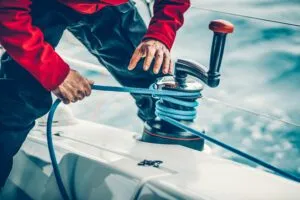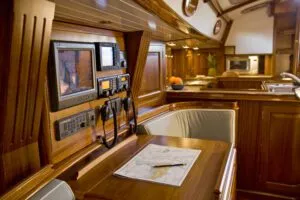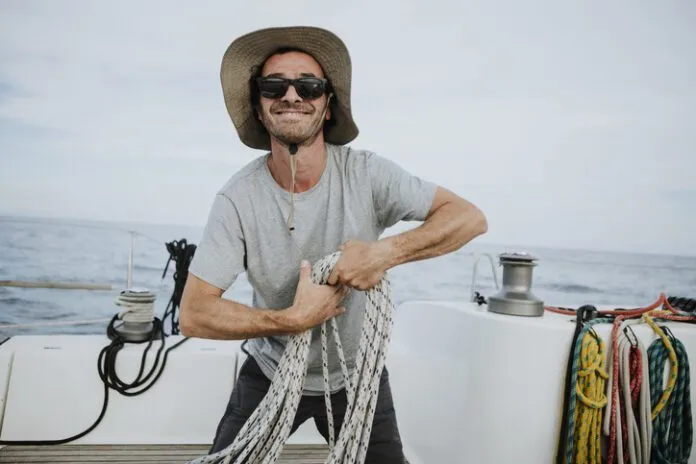Last week, I covered some of the things I suggest you need to think through on the boat before heading out solo. Now, what about the skipper? First issue you’ll have to ask yourself: “Have I got enough experience?”
And that is a difficult thing to measure. Some people may have been sailing for years and are still making the same mistakes they did as a novice. Others will do some training courses, read books, reflect on what worked and what didn’t after every trip, and will have developed a solid set of sailing skills within a couple of seasons.
I have met fully qualified skippers who did “fast track” training and although they have several thousand miles under the keel, it was not their keel, the bulk of the mileage having been logged on one or two offshore passages.

As a consequence, there was always a more experienced skipper on board. Compare that to someone who has their own boat and has built experience on their own on short coastal passages in tidal waters. The second skipper may have half the mileage, but does that mean they have half the experience? It is a very personal decision, but my general advice is to ask the following questions.
- Am I confident in my sailing ability and do I know my limitations?
- Have I had some experience in rough weather, and did I feel confident coping with it?
- Do I trust the boat, and do I know her well enough to fix anything likely to go wrong?
- Am I confident and comfortable making decisions on my own, or do I always like to talk it through with someone else first?
- Have I done anything else that involved being in a remote place, outdoors and on my own?
If you can answer those questions positively, then you probably are ready regardless of how many miles you have in your personal logbook. Let’s add some more questions.
WHAT HAPPENS IF I HAVE AN ACCIDENT OR GET SICK?
I think this is often a bigger question for those you live on shore than for many sailors. However, there are some important differences when you sail solo. First, there is nobody to take over if you are sick or injured. You either have to cope and get into port, or call a May Day. It is actually quite rare for people to get seriously ill on sailboats. Mostly we catch infections from other people, so if you are alone at sea there is nothing to catch! Obviously, if you have existing health issues you need to consider them and maybe get advice from a health professional (preferably one that sails!) Do you get seasick, and if you do, can you still manage the boat while you recover?

That is the most likely health issue unless you are lucky enough to never suffer. The other big difference concerns injuries. While not common, people do get hurt on boats. and if you are sailing solo, what are you going to do about it? If you cut yourself seriously, can you put a dressing on it? If you sprain an ankle, could you manage the boat? Could you put a splint on a sprained wrist or ankle? Could you flush an eye if you get something in it? I think anyone going to sea should have at least basic first-aid training and have given some thought to wilderness first aid. If you haven’t done a course. First aid training is, in my book, part of your duty of care to your crew. If you are going to sail solo, I suggest you go through the first-aid manual and think about how you would deal with each type of incident on your own. I would also suggest practicing. If you have never put a dressing on your dominant arm, give it a try, it’s harder than you think!
HOW WILL I COPE WITH BEING ON MY OWN?
Many people have never spent more than a few hours on their own, so this is a big unknown and the only way to find out is to try it. But start with some coastal passages, not an ocean crossing. Ideally, start by sailing in company with another boat. This can be a great way to explore. You agree on the anchorage you are going to head for each day and stay in radio contact on passage. It gives you a level of immediate backup if you need it, which means you have some company at the end of the day, but you get to experience solo sailing on passage. One of the questions I often get asked is “Don’t you get lonely?”

Honestly no. I have solo sailed, canoed, been mountaineering, and gone spelunking on some serious trips. The only time I get lonely solo sailing is in port. If you are surrounded by people, but still on your own, you can feel very left out. But that is very different from being alone. I actually find that if I am doing a solo trip, I am more likely to connect with locals and other sailors in port. With crew you tend to stick together and miss out on those connections. For me and many other solo travellers, one of the things we all say is that time alone is a good way to recharge the batteries. Taking time out from having to think about and support other people is the real rest. If that is you, then you will probably enjoy going solo. If you are not comfortable ‘in your own skin’, miss the interaction with other people, or lose confidence when it is just you, then solo activities are likely not something you would enjoy. I am definitely not suggesting needing to be a hermit or super introverted. People who enjoy solo activities are often very social when they are around others.
HOW SELF-RELIANT AM I?
Not only can I do things on my own, but I enjoy it. Having to rely on yourself can be scary for some. For others, not having to worry about how other people would do something or if they are thinking “That’s not how I would do it” can be a relief. As a nurse, I work in a complex and often emotionally charged environment. We also work in multi-skilled teams with lots of guidelines, treatment protocols and other constraints. Getting away on my own where I don’t have to think about all that is a great contrast! But again, this is a question you cannot answer until you try it.
HOW WILL I FUNCTION IF I AM SHORT OF SLEEP?
There are experts on how to cope with disrupted sleep and keep going without enough sleep, you probably already know one, they are called mothers! Solo sailing is a bit like looking after young children. The boat demands attention at all times, especially at night, and when it wants attention it wants it NOW, not in the morning or when you have finished your meal.

Everyone reacts differently to disrupted sleep to some extent but sooner or later it WILL impact you. When it does, some of the common symptoms are irritability, poor concentration, poor decision-making and increased risk of accidents. When it gets severe, this can include serious mental impairment including hallucinations and irrational actions. How much sleep you need is quite individual but if you don’t get it, it can get really dangerous.
So, what can we do? Most of us are used to having one block of sleep per day, usually at night but this is not the only way to get in your sleep hours. Once you get used to it you can break sleep into shorter blocks, sleep more during the day than at night or wake up, do something, and go back to sleep. It does take some practice, so it needs to be part of the learning curve for ‘going solo’. What you need to think about are your sleep cycles.
On average it takes about 15-40 minutes from when you hit your bunk to being fully asleep. You then go through two sleep phases, light sleep, and deep sleep. Many smart or sports watches can now monitor these sleep patterns and if you have one, they are great for keeping an eye on your sleep when on passage. They are also good for getting a better understanding of what your normal sleep patterns are. The crucial point is …ALL the sleep phases are important. Even if you are getting a full 8 hours a day, if it is broken up, you will never get your deep sleep and will start showing signs of sleep deprivation.
Personally, I find that if I get a block of 4 hours continuous sleep in the afternoon, I can get the other 4 hours in shorter naps without problems. But you do need at least one long block per day on a voyage of more than a few days. On shorter passages I can do about 30 hours of continuous duty before things become problematic. I have had 2 incidents where I had problems with exhaustion. Both with crew! In both cases I had to run to an alternative port in a gale and my crew was incapacitated by sea sickness. In the first case we got to port but I could not work out where the entrance was. There were 2 sea walls and the gap between them seemed to keep changing. My crew had recovered enough by then to come back on deck and when I asked them about it, they said “What are you talking about? There is only one sea wall.” I was so tired I was literally seeing double.
On the second occasion we almost made it to port after a run of about 75 miles, again in heavy weather and with seasick crew. We got caught in a severe tide race. The seas were so steep they felt like shore breakers. I was convinced I had messed up my navigation and was about to run aground, even though the depth sounder and chart plotter said we were in safe water. In that case I was so tired my thinking became confused, and I could not trust my decision-making. I called the local lifeboat, and they escorted us in. The problem in both these cases was that we were coastal sailing along a lee shore, so I had no sea room. Had we had 50 miles to play with, I would have simply hove too and got some shut eye. The other issue was that neither boat had a reliable autopilot, so I was stuck on the tiller for 24 hours or more in 30-40 knot winds and steep seas. Take exhaustion seriously. It is a killer!
HOW IS MY MENTAL HEALTH, AND WILL I RECOGNIZE AN IMPAIRMENT?
There have been very few cases where solo sailors have completely lost it and not survived. Donald Crowhurst, in the first solo circumnavigation race, springs to mind. He tried to fake going around the world by loitering in the South Atlantic, but it’s surmised he couldn’t face himself and he stepped off the boat, which was found abandoned. It is incredibly rare, and not what I am talking about here. Rather, what I want to talk about is the steady deterioration in mental health that can lead to depression, where everything seems too much effort and you stop looking after yourself. The opposite can also happen where anxiety reaches the point where every squall seems stronger than it really is, and you think it is the start of a full gale that is going to last days. Or you get paranoid about every minor boat failure and believe the boat is breaking up under you. These are symptoms associated with poor sleep, not eating well, and stress.
If you are sailing with a regular crew, there is a good chance they will see this happening before it becomes serious and as a crew you can do something about it. Solo, there is nobody there to say “Hey, you need a break,” someone who can pass a meal up to you. In most cases, the last person to realize they have a mental health issue is the person with the problem. That is just as true at sea as it is at work or home. What can you do about it?
One good plan is to give yourself a day off occasionally. If you are coast hopping, take an extra day in an interesting port or relaxing anchorage, go for a swim or a hike, clean the boat and make a special meal. Even on a long passage, you can take the opportunity that a calm spell offers to take a rest or heave-to for a day. This gives you the chance to clean up, take a shower, have a good meal and chill out. The important thing is, if you are taking a break underway, reduce sail, slow the boat down or heave-to so that you can have a day of not actively sailing.

WHEN THE GOING GOT TOUGH
A few examples that come to mind for me: Sailing across the Bay of Biscay, I had had a long stretch with little sleep on the passage through the Celtic Sea, followed by light and variable winds for a couple of days when I was working really hard to make progress. So, a week into the voyage and a few hundred miles offshore I dropped all sails on deck. Made a good meal, had a shower and about 9 hours of solid sleep overnight. The next morning, I was off with renewed energy and had a great voyage. On one Atlantic crossing, in this case with crew, we had gone through almost 3 weeks when the wind never dropped below 30 knots and the sea was breaking into the cockpit several times a day. Everything was so wet that we were sleeping in oilskins. When it finally cleared, we stopped the boat and went for a swim then took out all the mattresses and bedding to dry in the sun and cleaned the boat up, followed by a full night’s sleep. When we set off again the next morning it was like starting a new passage! The moral of all this is to say don’t drive yourself too hard. It’s not a race. Don’t be afraid to reset. You will sail better for it. With a full crew, a good watch routine includes regular ‘days off’ for each crew member to get a rest and do their cleanup chores while the boat is underway. In solo or short-handed boats this is done by slowing down or stopping so everyone has the day off.
Next week: Stockham on the art of picking a good crew.


































Thanks for the story and info. I will have to find a three day weekend to take off and give that a try. Still working for now. Mark Catalina 36, San Diego